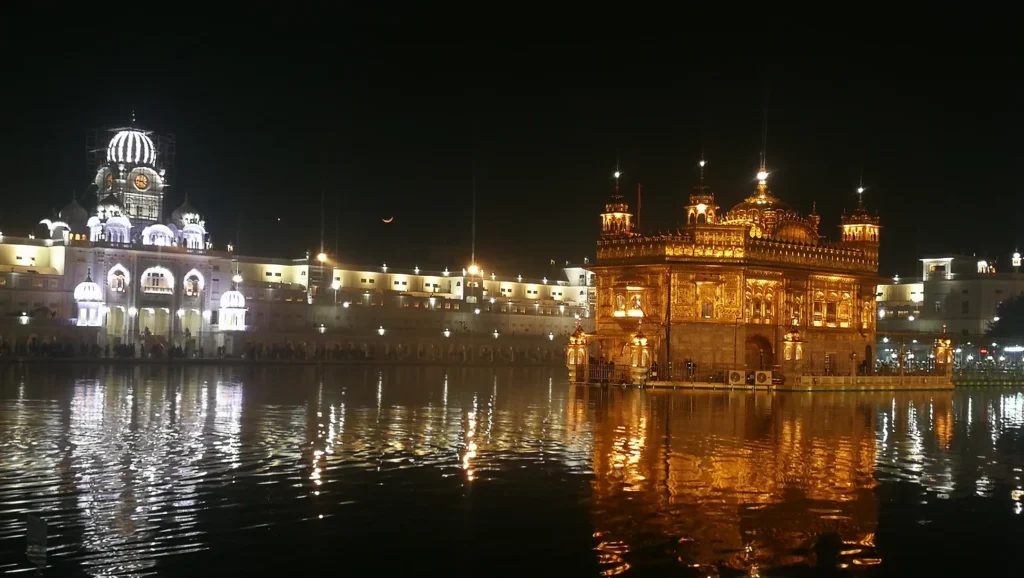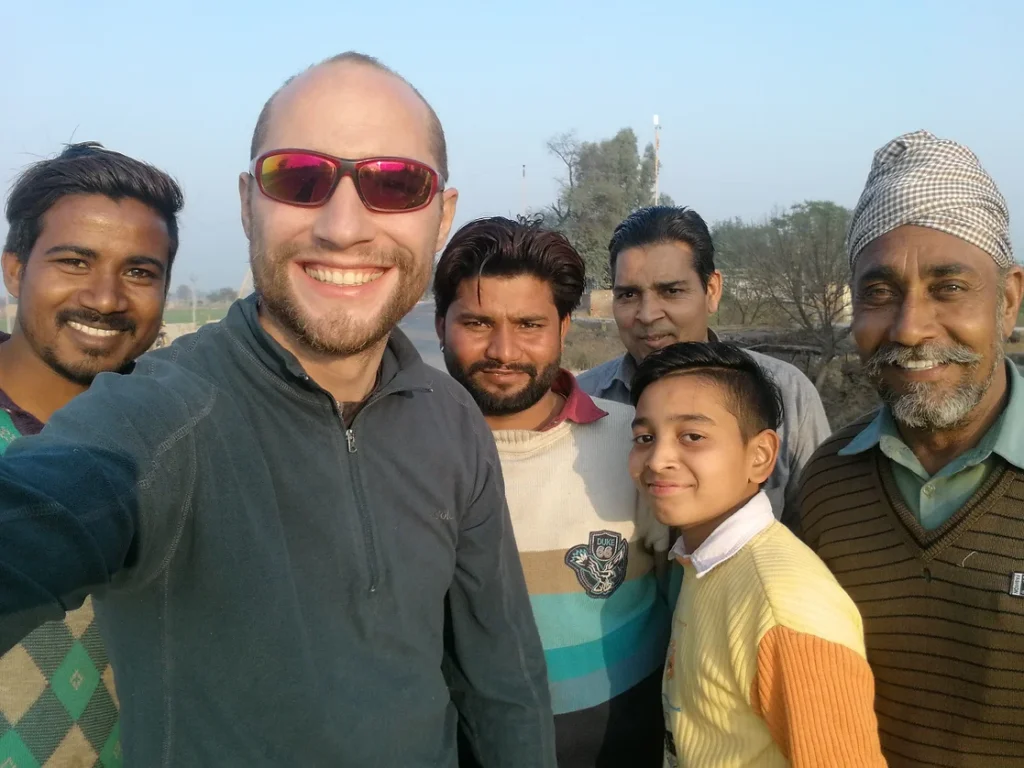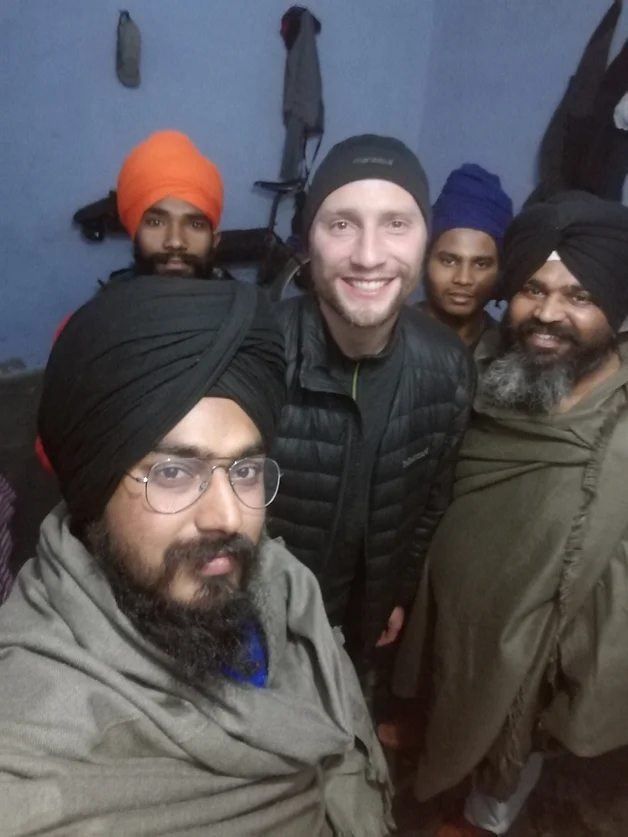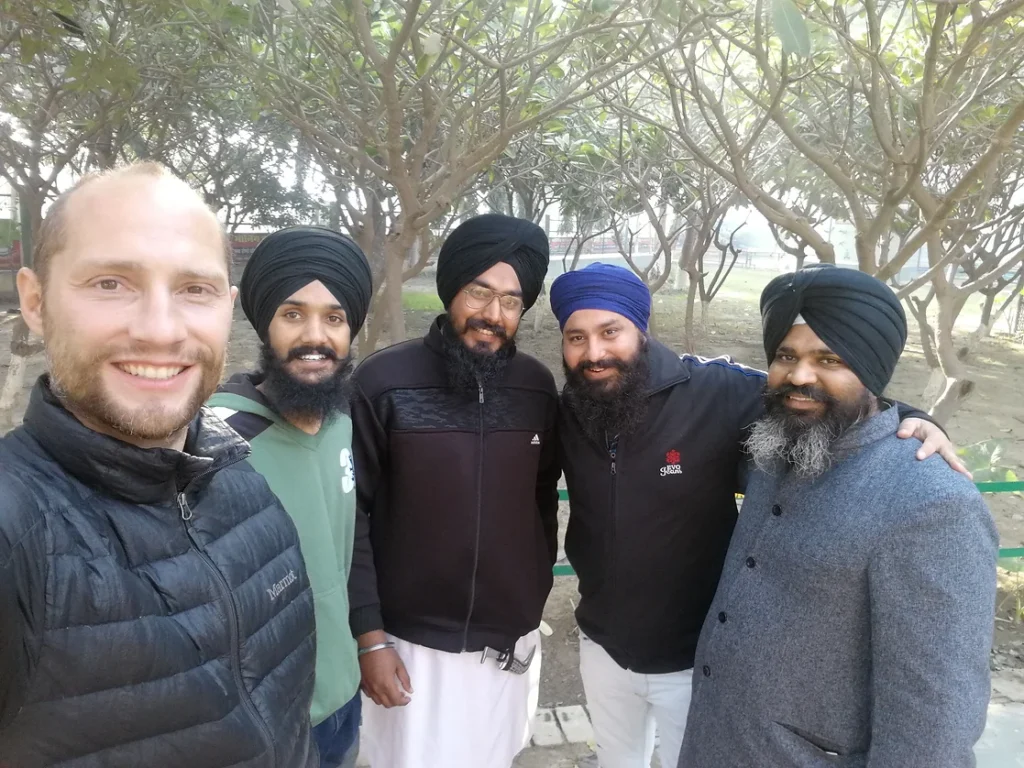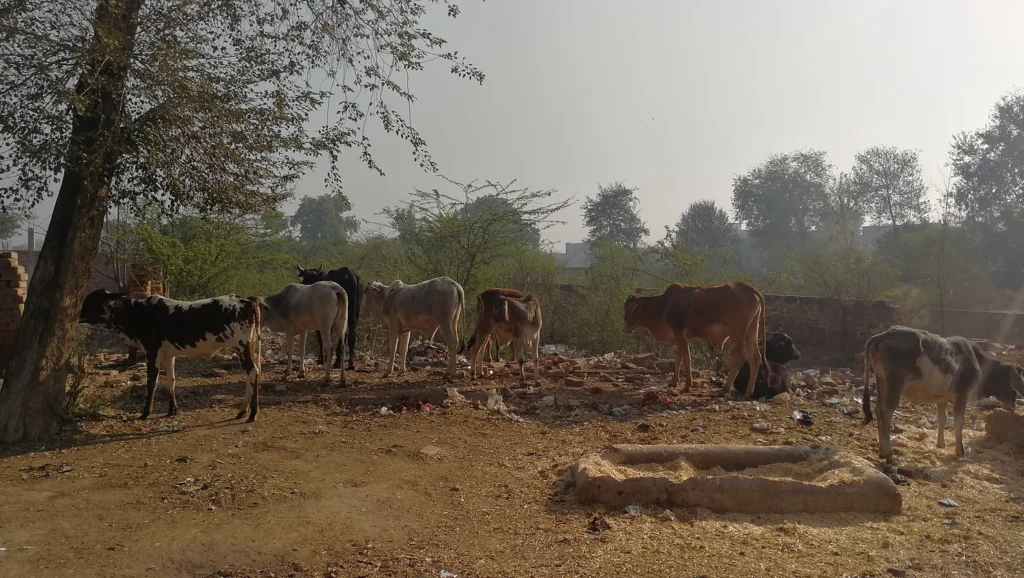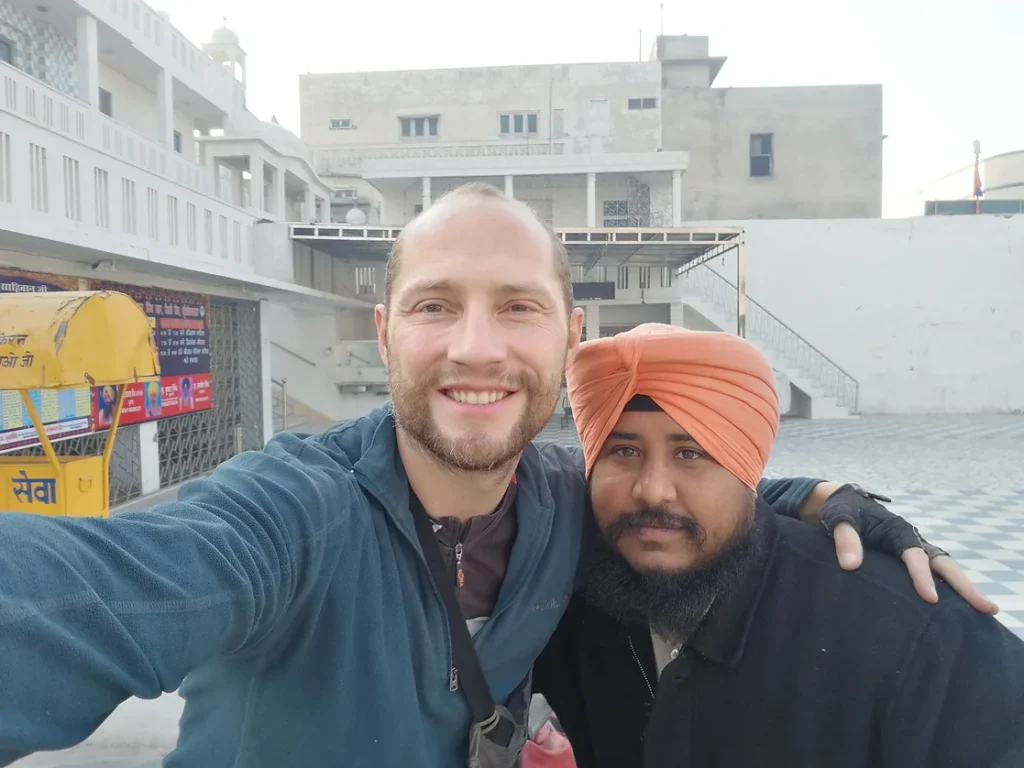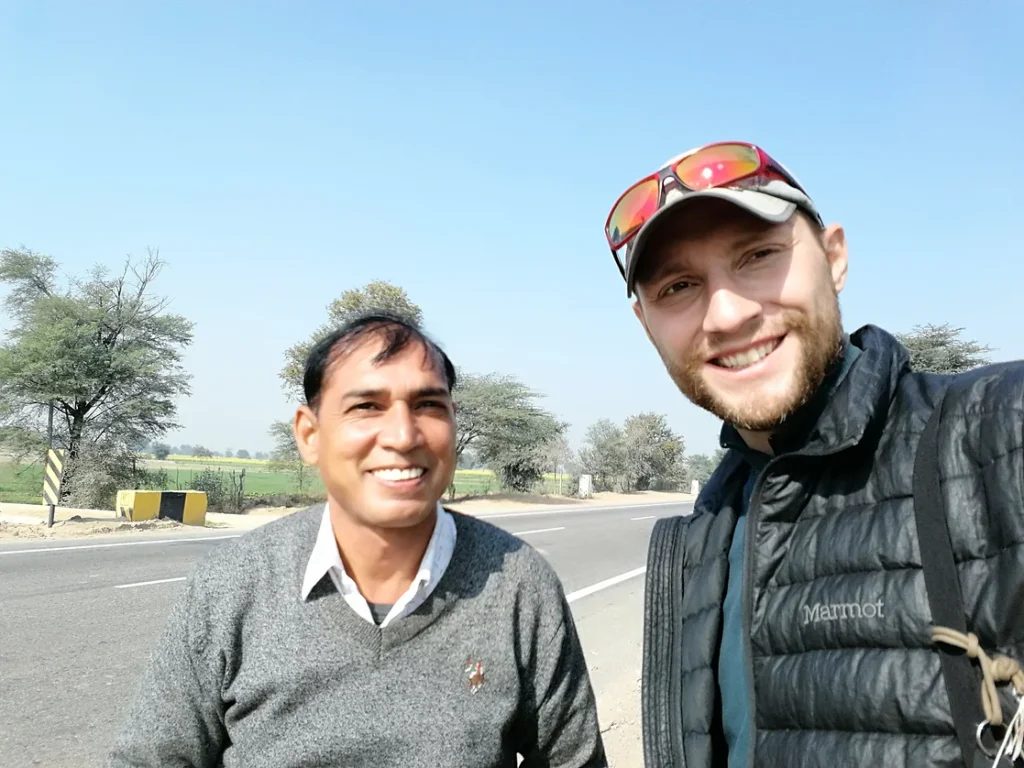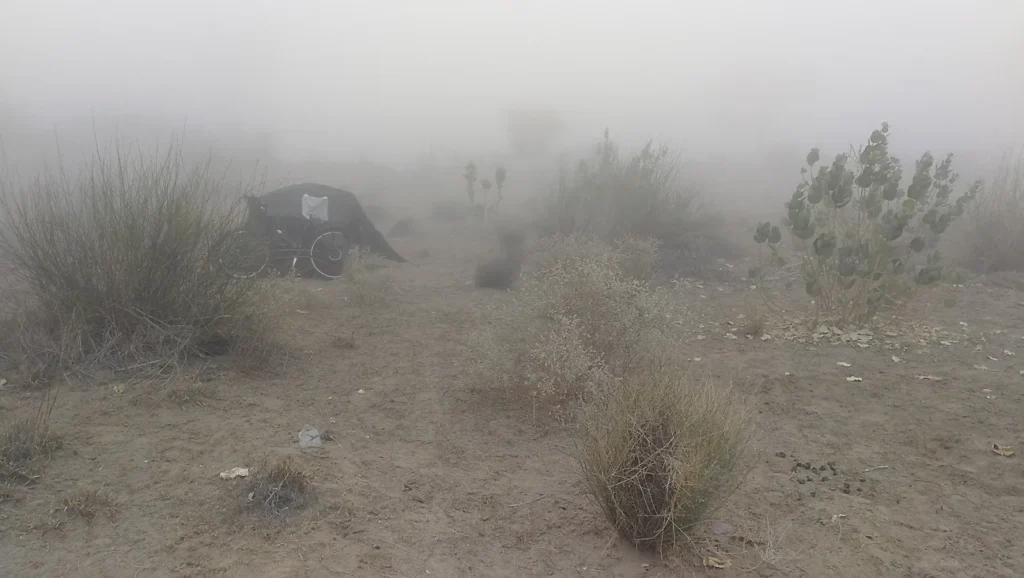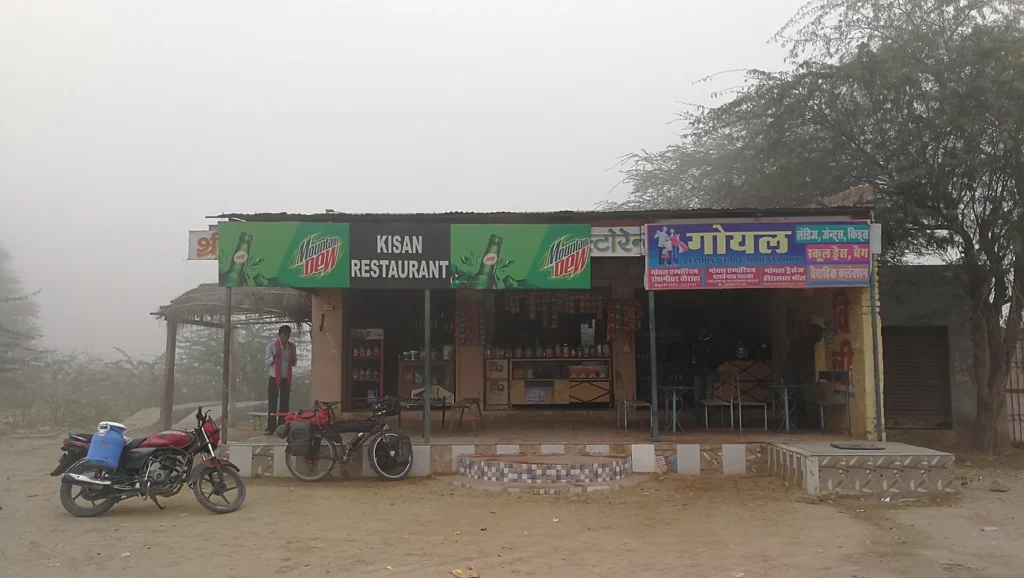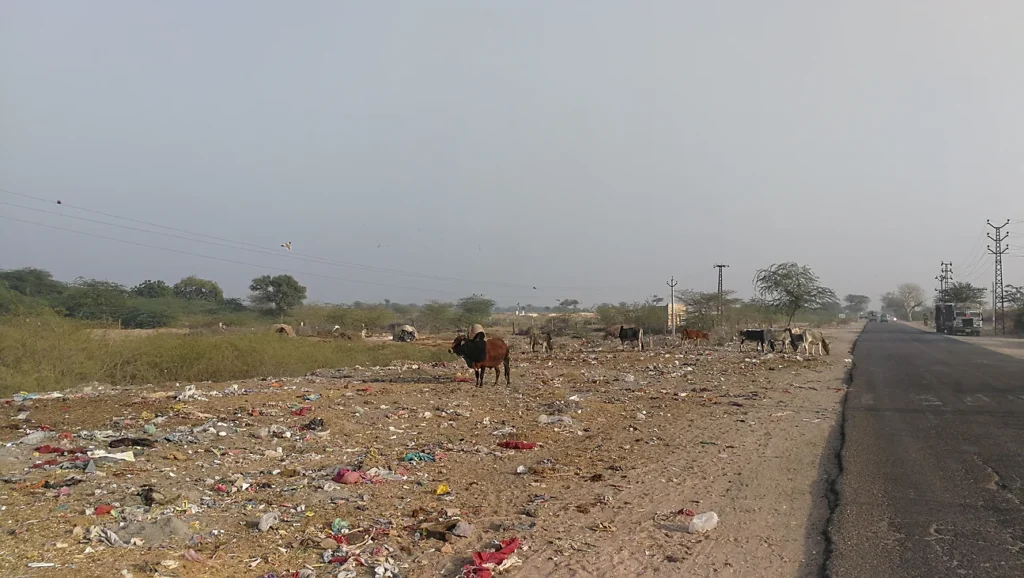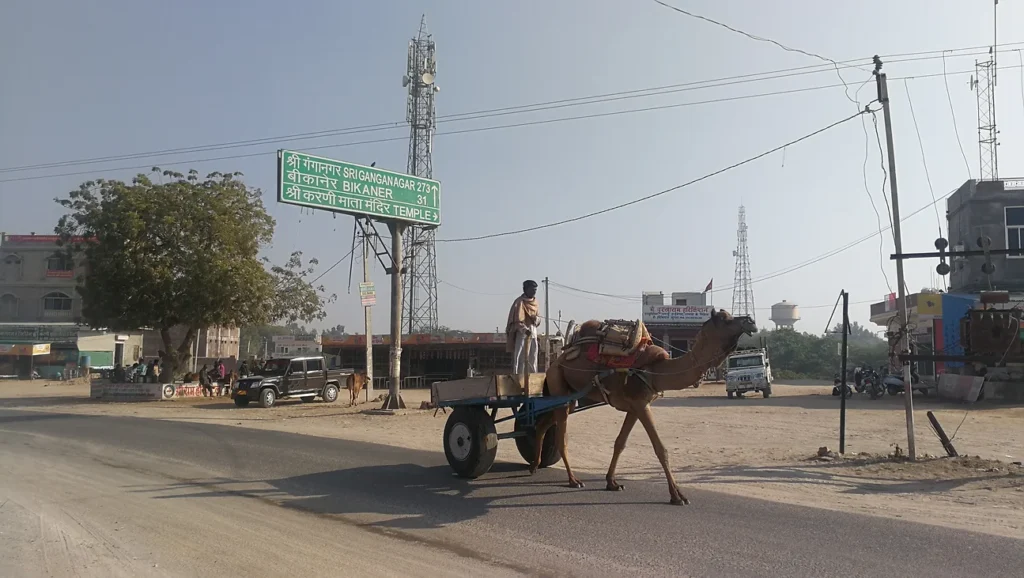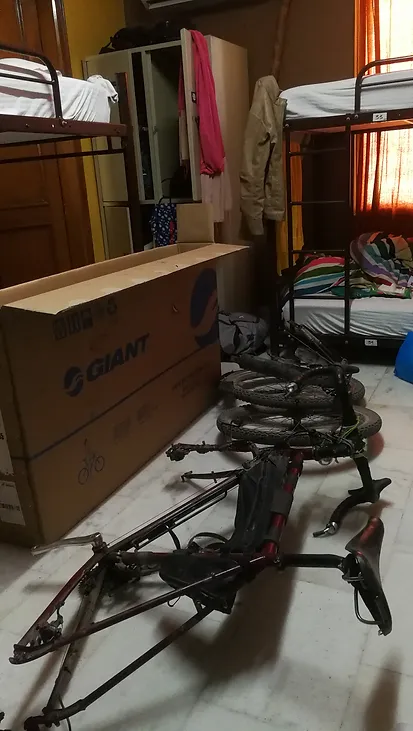India — Tolerance
The border crossing procedures were professional on both sides – the daily ceremony of Pakistani and Indian border guards includes a respectful human handshake between them.
I reached Amritsar in the evening and stayed in a hostel for a night.
In the morning I moved to the Golden Temple. It’s the central spiritual place of Sikhism, a religion that emerged in the Punjab region around 600 years ago.
The large temple area is an open place welcoming anyone without discrimination. You can sleep in the temple which I did – there is a community-focused atmosphere where people take care of each other.
Inside the temple is a langar – a public kitchen where everyone can sit together and eat a free vegetarian meal regardless of faith, religion, social status, caste, age, or gender. The langar is open 24 hours and feeds between 100,000-200,000 people daily making it the largest free kitchen worldwide.
The temple has entrances from all four compass directions symbolizing the Sikh belief in equality and that everybody is welcome. People visit the temple around the clock – a place might be packed in the afternoon but empty at night, also depending on ceremonies happening in different temple areas.
The flow of visitors is well-organized – if an areas is full, people just wait and stay relaxed until it’s their turn.
600 years is not that old for a religion. If you would found a new religion today how would you shape it? Can we all found our own religion?
Core elements of Sikhism are human community, acting for the greater benefit of everyone, honesty, self-reflection, and thinking for yourself instead of blind authority obedience. Sikhism is based on living authentic and true to oneself today (https://sgpc.net/sikhism).
And if there is no god and we are atheist – how do we shape our world concept, our values, the mental maps we navigate our reality with then? We are free inside either way, right?
Is it “external things” shaping who we truly are? Things outside our body and consciousness which we perceive with our senses – stuff we see, hear, smell, taste etc. … is that shaping us?
Or is it “internal things” shaping who we truly are? Things we feel inside our consciousness and body?
Who knows … perhaps both.
At the heart of the temple area is a large lake with a small golden building in its middle. One night I entered it around 3am when there where just a couple of people in line waiting.
The 2-story golden building is full of ornaments and lights. The atmosphere inside is something I would describe as a mix of “holy” and “natural”. People’s beliefs and consciousness attention could be seen and felt strongly but at the same time everyone seemed to be balanced, relaxed and happy to be themselves.
At most times there is meditative singing broadcasted in the temple complex – it makes the place feel alive.

On my last day in the temple I decided to end my bike tour in Nepal. From Amritsar the closest border crossing into Nepal was just five cycling days east but I first wanted to cycle for a while in India, starting with a southwest loop through the Rajasthan desert.
But I felt a bit unsure … what was the point of doing that?
Perhaps it all didn’t matter – the whole reality-consciousness thing. Perhaps it was all perfectly fine the way it was.
Some days in life our path is rough on the surface. You know this very well yourself, dear reader, the challenging side of our existence.

On other days our life path is smooth – like a brand new highway not yet marked on maps with tarmac so fresh and perfect that the road signs have just been put up on temporary wooden slats. Also this you know very well, dear reader, sometimes life is easy.
But whether our path is rough or smooth on the surface – does that really matter in the long-run of our life? Does that really matter on a deep level?
Our reality-bending force can be calibrated on stable targets if we choose so – things more stable than our daily life’s ups and downs.
For example, increasing the greater good for humanity is a consciousness directionality that’s stable – we can stick to it independent of whatever we encounter on our path.
And when we decide to use our reality-bending force to transform reality forward towards a more positive state, we naturally feel what’s the right thing to do even when we are in a million surprising situations we haven’t been before.
No matter whom we meet, no matter where we are – when we live by the value to pay attention to our fellow humans (force direction) and we do so with true compassion (underlying emotional flavor), we automatically know what to do. Like giving every human the same respect, being honest, being helpful … things like that.

Or as another example, executing against darkness is another consciousness directionality that’s stable – we can also stick to it independent of whatever we encounter on our path.
I mean “darkness” as a placeholder word for stuff we don’t like. Whether people are spiritual or atheistic and a million other things will determine what that means for us individually – everyone has to constantly find an own answer.
And then of course another consciousness directionality that’s stable is following what we love.
What do you love, dear reader? Who are you inside yourself?
I’m just a guy in a bicycle which is really not so special. And I’m sure you also think about life’s deeper meaning sometimes, I guess we all do.
Perhaps the whole reality-consciousness thing shouldn’t be taken to seriously. At the end we all die and our funeral van is exempt from paying road tolls.

But then again perhaps the whole reality-consciousness thing should be taken seriously. We all die pretty soon so if we don’t listen and feel into our consciousness early enough in life it may pass and on our deathbed we may have regrets that we haven’t truly lived in tune with our authentic self.
I cycled into the night and slept in a roadside restaurant.
What do you think happens after we die? Perhaps we all meet again to tell each other about the lives we have lived – to share the insights and lessons we have learned along our path.
If that’s the case I will be most excited to learn what my fellow humans have felt and seen in their consciousness during their lives! Would it be similar things? Would it be different things? Would the individual perspectives with which humans lived their live journeys differ fundamentally or be structurally the same?
I would probably focus more on listening than on talking when we meet after our death. Perhaps I would share that sometimes zigzagging south following the sun instead of navigating by map creates the best experiences – more spontaneous discoveries, more relaxed in the absence of a “goal” that could be missed, more unfiltered and authentic being oneself, more feeling.
And I would probably say that in my experience even if nothing of the whole reality-consciousness thing matters on a deep level, individually it matters a lot if we live our life following what feels right – following what we love.
I wonder if you sometimes consciously stop running from your pain and face the things scaring you. Perhaps also this is build into our life path and we all do it, just in different forms and at different times during our life.
Who knows what’s true anyways. Do you?
Perhaps life is meant to remain a big mystery. Perhaps all we can do is scratch reality’s surface with a tiny bit of speculation on how things are.
Fine people at the restaurant – I’m not sure how many foreign tourists they have seen before but they let me sleep inside their place as the most natural thing of the world.

A cool thing in India is that people use bicycles both in the countryside and in cities. This may sound trivial but in many countries there is no bicycle culture at all – in my view the world can learn many intelligent behaviors from India.
An early cyclist was Mahatma Gandhi, born 1869. As a firm believer in seeking truth and standing up for it nonviolently to change the world, he based his actions on self-reflection and an awareness of his reality-bending force:
“There is an indefinable mysterious Power that pervades everything. I feel it, though I do not see it. It is this unseen power which makes itself felt and yet defies all proof, because it is so unlike all that I perceive through my senses.”
Gandhi emphasized that true empowerment and liberation is only found inside ourselves and not externally – everyone should follow his or her own inner voice.
Cultivating a world based on non-violence and tolerance, standing up for our own values, following our inner voice and feelings – I think the world can learn many more intelligent behaviors from India than having a bicycle culture.
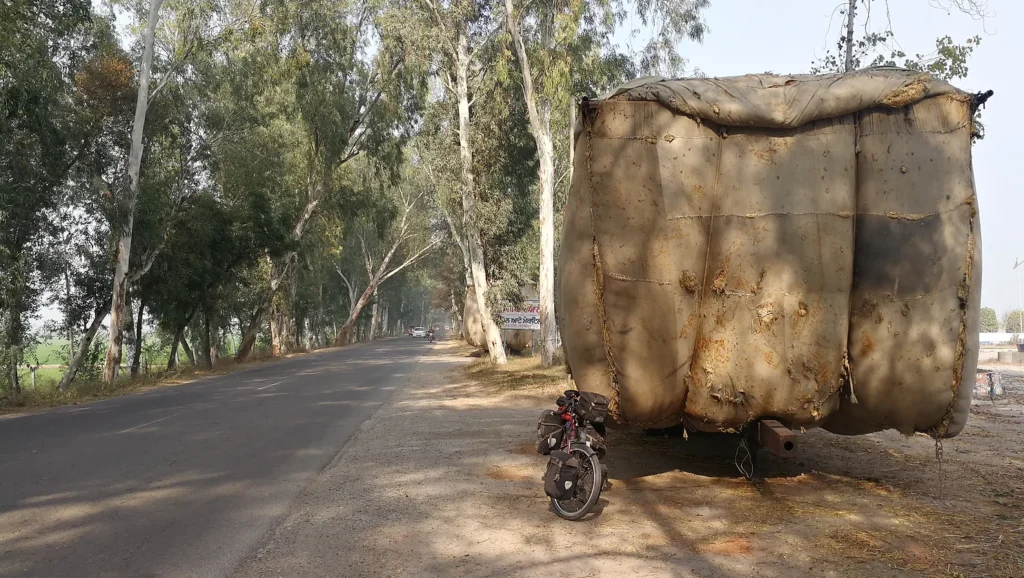
Let’s revisit for a moment the idea that after we die we all meet again to tell each other about the things we learned during our lives. Which lessons would you share?
I’m sure you have as many valuable insights and ideas on life as Gandhi or me or anyone else – in my view everyone knows unique things that can help others.
So when you look at the river of life you have experienced since your birth: What stood out? Which lesson would you share with somebody you want to give the best advice possible? Which lessons would you share with someone you love?
Of course I don’t know what happens after we die. Do you?
But I know that we all learn things during our lifetime – structurally seen, we all constantly learn and evolve.
And given this structural similarity, we can see ourself in others and others in ourself.
This “seeing ourself in others” thing, it somehow makes life deep.
But to unleash it’s potential, the philosophical idea of seeing ourself in others requires something beyond thinking such words, something more real than a thought.
Perhaps when we imagine how the physical body of a specific other human feels from the inside, when we imagine that we literally morph into the other person for a moment, when we feel their blood pumping through their body, when we feel their lungs breathing in and out, when we become him or her – perhaps that can be a door, but I’m sure there are many.
This “seeing ourself in others” thing, it can be practiced particularly well on smaller roads. People there have more time, no traffic disturbs the encounter, and it’s also more special for both sides to meet someone unknown whereas on highways (and in cities) people are generally more distant.
Seeing ourself in others – it somehow creates compassion.
And while there are many benefits on the receiving side of compassion I’m convinced it’s equally beneficial for ourselves when we give it.
Perhaps the really important things happen subconsciously during human encounters. Like automatically sensing into each other … I don’t know.
Of course there is our visible behavior, like smiling and shaking hands and sometimes giving a high five, but to me it seems that there is more going on under the surface of our perception.
But human encounters are often simply fun and feel good – no philosophy required. If we don’t chat we people, how would we learn about their lives?

India is a good place to practice self-reflection and tolerance. At every corner you get impulses like “the culture I’m used to is only a drop in the global ocean of diversity”.

Do you think you can feel into entire countries and cultures?
When we imagine that we literally morph into an entire country or culture for a moment, it’s like “seeing ourself in others” with a collective perspective. Who knows, perhaps we all constantly do this by existing as embedded beings sensing our environment.
In Abohar I went to a Gurudwara and got invited to stay there for the night. A Gurudwara is a Sikh community center and place of worship in combination where everyone independent of their religion is welcome.
At 6am I joined my hosts for their daily morning ceremony. The people involved took turns and formal roles seemed to be secondary – it appeared more that the act of individual worship was the center of people’s attention.
A core part of Sikh worship ceremonies is music – meditative, soothing, and somehow deep.
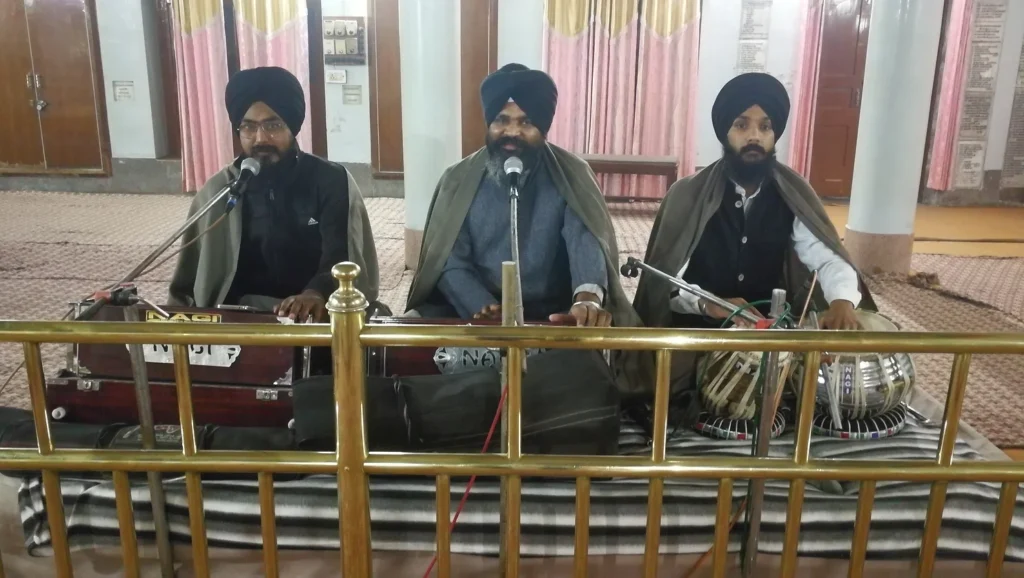
The Sikh are great people. You can clearly see the effects of their daily meditation as they are all balanced, resting in themselves, and joyfully present.
Sikhs pay particular attention to the development of their character. In order to grow and unfold in life, Sikhs make listening to their inner dialogue a priority.
The Sikh in Abohar told me their city gets 2-3 tourists per year. I felt grateful for the warm hospitality and trust they gave me.
My hosts suggested a city tour and I happily accepted.
Our first stop was Nehru park in the city center. Here a “Morning Club” organizes yoga sessions which everyone (general public) can freely join to do some light yoga in the morning together and start the day in community. Pretty cool – we should introduce this in Germany.
In the park is a statue of Swami Vivekananda – a 19th century Hindu monk who is considered one of the most influential people of modern India.
Vivekananda was a spiritual teacher, philosopher, author and visionary who established many bridges between India and the rest of the world – for example, he is credited with bringing knowledge about Hinduism and yoga to the west.
In 1893 Vivekananda participated in the first meeting of the “Parliament of the World’s Religions” in Chicago as a representative of Hinduism. This was the world’s first conference to create a global dialogue on faith.
The idea gained momentum during the last years and is currently carried forward by a non-profit organization with the vision:
“In the world we envision:
- Religious and spiritual communities live in harmony and contribute to a better world from their riches of wisdom and compassion.
- Religious and cultural divisions and misunderstandings are replaced with respect and understanding.
- The richness of human and religious diversity is woven into the fabric of communal, civil, societal, and global life.
- The world’s most powerful and influential institutions move beyond narrow self-interest to realize the common good.
- The Earth and all life are cherished, protected, healed, and restored.”
Our next city tour stop was a Hindu temple. The temple was overall devoted to god Hanuman and contained statues of several other gods, including goddess Durga and the god-pair Radha-Krishna.
Hinduism is the world’s oldest religion by many measures. It’s a question of definition what a “religion” is and what “oldest” means – nobody knows exactly how our ancestors developed their spiritual beliefs thousands of years ago.
But we know today that the body of beliefs representing Hinduism forms one of the major world religions with over 1 billion active followers worldwide – most of them in India and Nepal.
The number of gods in Hinduism varies from “33” (total) to “330 million” depending on the source. While the millions-of-gods-estimate is probably a metaphor for the vastness and diversity of the universe, the general polytheistic split-up of the ultimate god into sub-gods may have developed for pragmatic reasons.
Perhaps the highest single unity binding everything in the universe was conceptually split into sub-gods (with distinct personalities and powers) as this allowed more differentiated worshiping (“specialist gods on topic xy”)? Or perhaps because the tolerant base of Hinduism allowed an inclusion and accumulation of new beliefs while the religion was growing?
The Bhagavad Gita, one of the holy scriptures of Hinduism dating back about 2,200 years (when older texts probably got composed), contains the following statement on religious tolerance:
“Whatever celestial form a devotee seeks to worship with faith, I steady the faith of such a devotee in that form.”
The message contained is this: the paths to the ultimate god beyond human-made concepts are diverse and we are encouraged to follow our individual belief path in our consciousness – ultimately all paths lead to the same destination.
Hindus believe that our vision of reality is clouded by worldly illusions (maya) but that we are able to realize the ultimate truth of oneness (brahman). During our lifetime we are free to do good and bad things influencing our karma. And depending on how we have lived our life after our death we get either reborn in the cosmic reincarnation cycle (samsara) and keep learning, or we break free (moksha) and merge back into brahman
And the way we know which things are “good” or “bad” in our life, the way we realize the deepest and highest reality is to look inside ourselves, not externally. For Hindus it’s our lifelong quest to find brahman inside our individual self (ātman) – by feeling and listening into our consciousness.
Across the street from the temple a herd of stray cows in challenging conditions served as a reminder that independent of any spiritual beliefs life can be tough. Would the cows be happier if they knew that their condition was just a worldly illusion?
Realizing the ultimate reality, the ultimate truth of oneness – if this “realizing” wasn’t something word-based like a philosophical thought but rather something feeling-based, then any articulation of a “religion” or “spiritual belief” can only be a signpost pointing towards something deeper.
So perhaps the whole consciousness exploration thing should be approached less cognitive-analytical?
We continued our city tour and went for a motorcycle ride through some narrow downtown streets and a market. The most common vehicle I saw here were bicycles which will for sure give good karma.
Back in the Gurudwara I received a surprise from my hosts.
In the Sikh culture the color of the turban has a meaning. For example blue represents “warrior”, white represents “clear mind”, and black means “surrender of the ego”.
Receiving the color orange had a special meaning to me beyond its traditional interpretation – it meant friendship.
Smokey stretch west of Abhohar. Could have been an intentional fire to clear the roadside – the fire didn’t seem to damage the larger trees.
In the afternoon I reached Rajasthan – India’s largest state by area.
In the evening I went to a Gurudwara in Sri Ganganagar and was invited to stay there for the night. In Punjab (India) Sikhism is the largest religion but in Rajasthan the Sikh account for only 1% of the population so it was a good opportunity to learn more about the Sikh culture before cycling further south.
In the Gurudwara attended a ceremony by my hosts – I was the only person in the audience.

A reporter who had heard about my journey came by to interview me for a local newspaper. I was happy to speak with him but it felt strange – before I hadn’t told anyone about my bike tour except for some close friends, never gave an interview … so far I had basically been cycling in my bubble.
The reporter came with a photographer and we talked for over an hour. They were really interested in my experiences in different countries which surprised me – I never considered the tour as something special.
I shared with the reporter that I wanted to finish my bike tour in Nepal in about 3 weeks – Bikaner/Jaisalmer/Udaipur/Bundi in Rajasthan, then Agra in Uttar Pradesh, then crossing into Nepal and finishing in Kathmandu was my rough route plan.
All flat terrain until the last 100 kilometers before Kathmandu, a visa on arrival was available at the Nepalese border – from a cycling distance, route complexity, weather, safety, and overall feasibility perspective this plan was easy to execute.
It was the first time that I spoke with anyone about the end of my tour. When you cycle alone over months without a fixed tour end in mind, the “ending topic” and related the deeper “why topic” are always in the blurred future. But now my plan to finish in Nepal was even printed – kind of specific, like the quantum wave function of infinite possibilities suddenly collapsing down to one tangible answer obtained by the observer.
I couldn’t really grasp why, but I felt peculiar.
In the morning I thanked my host for his hospitality – the Sikh are beautiful people with big hearts and their service for the community and greater good is an inspiration.
Friendly folks near Netewala.
Friendly folks near Manjhuwas.
In felt regret that yesterday I spoke about pesticide usage in the Punjab region with the newspaper reporter. He had asked me if I had some advice for Indian people and I naively said something like “use less pesticides as it makes people sick” – and it got also printed in the article.
While pesticide usage is indeed a big problem in the Punjab region, the issue is much larger and multi-layered: low market prices for agricultural products (consumers want cheap, right?), high-rate loans (e.g. to buy seeds), drug addiction (opium reduces appetite enabling longer work days in the fields) – small farmers in Punjab struggle to survive, and suicide rates are high.
As a foreign visitor I didn’t want to “give advice” to anybody but with interviews you never know how things come across. I’m sure the local farmers are well aware of the pesticide risks and use them out of economic necessity – I should have said something more constructive.
Have you ever stopped and really thought about other people’s lives? Their pain, their joy, how they are doing?
Have you ever stopped and really thought about your own life? Your pain, your joy, how you are doing?
Have you ever really stopped and asked yourself what life is all about?
On the first day of our tour, when we looked into the raw nature of language, a maxim inscribed on the entrance of the Temple of Apollo in Delphi started our thought chain: “Know Thyself“. There was a second maxim inscribed: “Nothing in excess“.
“Nothing in excess” leaves much room for interpretation. I believe it’s healthy advice for consciousness explorers too … approaching our individual self-reflection too word-based, too cognitive-analytical will only get you so far.
The question “Who am I?” can only be a signpost pointing into the direction of ourself. Yes we are also the thoughts in our mind, the “story” we tell ourselves about ourselves – but we are equally, if not more, our feelings and body.
Perhaps life was at its essence about loving all parts of our existence?
Sometimes life gives us tangible reminders that we are biological beings and not just “thinkers” – today I got sick for the first time on my tour and decided to get a hotel room in Suratgarh.
Happy New Year! I stayed three days in the hotel until I recovered.
Since Berlin I had used few items from my first aid kit. Plaster and wound disinfection occasionally for small cuts. Painkiller once in Turkey when I tore a muscle. I never had stomach issues but here in Suratgarh I was happy I brought diarrhea tablets, charcoal tablets and electrolyte-glucose mix to recover from liquid loss … I used it all.
On day three I went outside to buy some fruit.
I knew my stomach would soon be fully recovered but I felt strange emotionally.
I had left Berlin 290 days ago and I had cycled and camped most of the time alone. Being alone on Christmas and New Year probably also added to my mood – I felt lonely.
Have you ever cried feeling lonely and sad?
It feels really good and authentic. It feels like accepting the own vulnerability. It feels like being honest.
In India, I probably allowed myself for the first time to let all my feelings fully arise – to really feel them instead of thinking about them.
Fuck philosophy, fuck mental maps, fuck thinking – feeling myself has been the best experience of my tour.
Stomach recovered, back in the saddle. It’s always nice when positive people say hi on the road – it’s like a little energy boost and often it’s quite funny to do a round of selfies together with everyone’s phone.
The roads in Rajasthan have pretty good tarmac, there isn’t much traffic, and given that it’s flat it’s easy to cover large distances comparatively fast – if you want to.
In Rajasthan you see lots of camels as work animals. Since the 1990s their number declined from almost 1 million to around 200,000 but the government has taken steps to stabilize the population – including setting up a National Camel Research Centre in Bikaner and making the camel Rajasthan’s official state animal.

Sometimes I saw gazelles elegantly jumping away after seeing me. Rajasthan is home to a large number of wildlife including leopard, stripep hyena, and the Bengal tiger.
In Arjansar I stopped for water. The truck stops here often have comfortable beds in front were you can relax and observe the scenery.
And if I turn left and cycle into New Delhi and end my Silk Road tour there? It would just be three cycling days away.
I had a six-month tourist visa for India and could find many more external adventures in this fantastic country. But for me at this point further external adventures had lost a bit their appeal – I didn’t know what it was but I felt strange.
Just three more weeks on the road, seeing another country, and finishing in Kathmandu surrounded by the world’s highest mountains would sure be great … was the “rational thought” I heard in my consciousness. I therefore decided to complete my Rajasthan loop and cycle into Nepal as I had planned – so I went straight ahead.
In Mahajan two gentlemen on a tractor stopped to say hi. I was interested in their enormous hay load and they were interested in me. Perhaps we are naturally interested in what we don’t know yet?
Very fine people – I would have liked to learn more about their lives.
The thing is when you live on the bike most of the time you just say hi and then you cycle on. Perhaps you take a picture together, perhaps you get invited for a tea, and sometimes perhaps you even stay with people for a couple of days and become friends – but you always move on and leave everyone behind.
There is a difference between all the locals you meet on a long bike journey and you in the saddle. Everyone else has a much more stable surrounding in life – a home, friends, family, and local community. But you are always the lone rider surfing the endless stream of new adventures and encounters. And there are two sides to it.
From the outside people see the adventurer – the long-distance cyclist crossing mountains and deserts and all that. And while this is true I am convinced that inside we are all the same.
Human’s have paraphrased the whole life-consciousness thing in many different ways. Words of philosophy and spirituality, words of just trying to life our life well.
No matter if you belief in atheism or in a religion or in any other mental concept you use to make sense of the world – crossing mountains and deserts is what we all do inside our consciousness every day of our life.
It’s our handling of the stream of reality flowing through us. It’s our choices regarding our consciousness attention while we perpetually transform forward. It’s our feelings and thoughts and senses. It’s our body and biological life – our breathing, our beating heart.
One way or another, we all exist in transition.
In the evening I pitched camp and enjoyed the silence in the desert. If you can rely on one thing in life it’s that the desert gives you space to be yourself.
At night a dense fog had made everything inside my tent surprisingly wet. But in the morning the sun was too weak to properly dry things so I packed up a wet tent and wet sleeping bag.
In the afternoon I unpacked to dry my things for an hour but there was still mist in the air and the drying didn’t really work – I still burned my face despite sun cream.
What is your state of thinking regarding the ultimate meaning of life? And whatever it is – how did you get to this point of conceptualizing reality?
The Dalai Lama says today’s world requires humanity to think more for themselves than ever before: given global interconnected issues like war and poverty and environmental destruction, given the diversity and complexity of the challenges we face, given also our enormous scientific and technological advances – he argues that mindfulness of our emotions and clarity about our values are universally helpful tools for everyone to use and benefit from.
Regarding spirituality the Dalai Lama suggests that people stay with their religion or set of beliefs, and add self-reflexivity:
“At the outset I should make it clear that my intention is not to dictate moral values. Doing that would be of no benefit. To try to impose moral principles from outside, to impose them, as it were, by command, can never be effective. Instead, I call for each of us to come to our own understanding of the importance of inner values. For it is these inner values which are the source of both an ethically harmonious world and the individual peace of mind, confidence, and happiness we all seek. Of course, all the world’s major religions, with their emphasis on love, compassion, patience, tolerance, and forgiveness, can and do promote inner values. But the reality of the world today is that grounding ethics in religion is no longer adequate. This is why I believe the time has come to find a way of thinking about spirituality and ethics that is beyond religion.”
I’m sure you have your own perspective on self-reflexivity and spirituality and inner values. Whatever it is, I wish you from the bottom of my heart that you find meaning and fulfillment in your life so that the day you die, dear reader, you will smile warmly and feel that you have lived your life well – that you have truly been yourself.
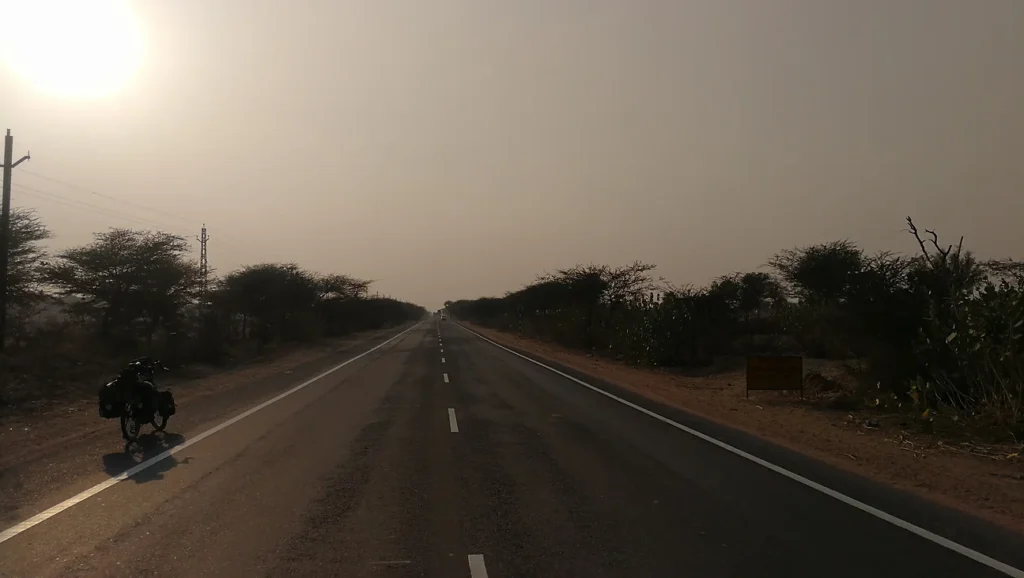
I pitched camp close to Jamsar having cycled just 70 kilometers today. I felt tired emotionally but somehow also happy.
This morning the fog stayed after sunrise so I packed my things soaking wet again – sometimes you can just practice acceptance.
Normally wherever I camp in the world I follow a strict “leave no trace” philosophy. Since leaving Berlin the total volume of garbage and items I left behind in nature so far was zero.
But here in the fog of the Rajasthan desert I made an exception and left my spare tire and two new spare chains behind in the desert. Having decided that my tour would end in three weeks in Nepal, there was no more need for them and I wanted to give this reality a confirming gesture.
Sorry for that one mother nature. Next time I’m in Rajasthan I’ll visit the spot again and pick the things up.
Meditative morning. I cycled slowly, feeling peaceful.
I reached Jamsar and stopped for water. Also here, just like pretty much everywhere I stopped on my tour in the middle of nowhere, the locals were cool.
You smile, they smile, it’s kind of easy to connect. And the very large majority of people in this world is really warmhearted and welcoming and wants the best for everyone.
In Khara I stopped for a tea.
Take a moment to look at the locals – what do you see?
I see people who can be proud of their cultural heritage. Since over 2000 years India has maintained a culture of tolerance and diversity – values central to long-term peace.
There is the aspect of religion. India is home to a majority of Hindus, the world’s third largest Muslim population (200 million), and about 60 million Christians, Sikhs and Buddhists.
There is the aspect of politics. India has multi-party system empowering citizens across the social, cultural and geographical spectrum to bring in their perspective to debates so every voice is heard and everyone’s values are considered.
There is the aspect of consciousness attention. India’s national motto is Truth Alone Triumphs (Satyameva Jayate) taken from the over 2000-year old Hindu scripture Mundaka Upanishad. And India’s national anthem Jana Gana Mana (Thou Art the Ruler of the Minds of All People), composed by India’s first Nobel laureate, has these lyrics:
“Thou art the ruler of the minds of all people, dispenser of India’s destiny. Thy name rouses the hearts of the Punjab, Sindh, Gujarat and Maratha, of the Dravida, Orissa and Bengal. It echoes in the hills of the Vindhyas and Himalayas, mingles in the music of the Jamuna and Ganges and is chanted by the waves of the Indian Sea. They pray for thy blessings and sing thy praise. The saving of all people waits in thy hand, thou dispenser of India’s destiny. Victory, Victory, Victory to thee.”
Directing a national motto and national anthem to something larger than nationalistic ideas (such as “our country is the greatest”, “we fight”, “our political party above others” etc.) reflects that India is a society of deep thinkers giving their attention to things connecting us all – and pragmatically to values like unity in diversity, pluralism, and tolerance. India has my respect.
In these gentlemen in Khara I also see the future of earth. Half of the current world population is younger than 30 years and this generation’s values and decisions will be central in shaping the future of our species.
And in this group of locals I see humanity’s oneness. When I look into their eyes, I see people of exactly the same value like you and me – humans handling the reality stream flowing through them, humans perpetually transforming forward using the force.
And if I ride straight down to Kandla Port at the Arabian Sea? I could be there in a week. The salt desert near Kutch and the Gujarat region in general must be amazing. Then I could cycle further south and see wild lions in Gir National Park, and then perhaps cycle east to see wild tigers in the Satpura range.
Once you are on the road, cycling longer comes with marginal additional costs. If you mostly wildcamp and eat self-cooked rice and lentils with some vegetables – how much more than 5 Euros per day can you spend even when you buy bottled water?
And the “finding back into life” task would be the same in a couple of months. Finding a new apartment and job and everything around it, rebuilding a professional life – it would be exactly the same challenge a couple of additional months in the future.
I was a true adventurer, right? I had dreamed of cycling to Asia for many years and now I was on the road and still had more than 5 months left on my Indian visa – continuing to cycle in this amazing country was an adventurer cyclist’s dream, right?
Those were all valid “rational thoughts” – but how do you draw the line and end an expedition? Do you go as long as possible?
At noon I reached Bikaner and cycled around downtown.
Bikaner has much to offer. Historic forts, temples, India’s National Camel Research Center – but I decided to directly leave Bikaner and cycle on to the Temple of Rats in Deshnok, a city 30 kilometer south.
So the privileged white German on a long vacation wants to always see the next attraction, right? So this whole self-finding trip is just about consuming the next external adventure, or what?
Those thoughts were getting louder. It’s easy to smile on pictures but honestly at this point of my bike trip I felt doubt – I wasn’t sure anymore what I wanted.
I didn’t understand it back then but now I realized that there are different forces pulling and pushing you on a bike trip. You can keep cycling because you want to experience more adventures on the road, or you can keep cycling because you are afraid to return and face your life – a long bicycle journey can become a way to run away from your fears.
While cycling out of Bikaner I met a Sadhu. It was just a short encounter but what resonated with me was his gentleness.
I stopped in the afternoon for one hour and tried to dry my sleeping bag and tent but it didn’t really work because of the mist.
You know honestly, sometimes cycling conditions can cost you some energy to handle.
Sometimes there is a little bit of traffic, or some sand, or other things like that costing you energy.
In Deshnok I checked into a hotel and then went to the rat temple. The thousands of rats run over your naked feet when you stand still but they generally behave nicely.
The Karni Mata temple website contains the following words of truth:
“In the land of mystical cultures, traditions, innumerable temples and shrines, India has always been the prime choice for mystery seekers all across the globe. Only in India will you find a new language, a new tradition, diverse set of myths and beliefs at every street corner. There is always going to be something that will truly leave you mesmerized every time you decide to travel in the country!”
While I would say you can go on a mystical journey in every country or in fact wherever you live, India for sure offers you many impulses shaking your previous world conceptions – which may indeed be helpful to find out who you really are.
I packed my bags early and left the hotel with a decision. After cycling 15,000 kilometer through 24 countries, I had realized that my bike expedition was completed. I had found some answers I was looking for, and I had decided to go home.
For the first time since starting in Berlin 10 months ago I turned around and cycled back to Bikaner to take a bus into New Delhi.
In Bikaner I got a ticket for a night bus and waited most of the day in a small park next to the bus station.
In the evening I went for a walk near the bus station and felt that I had taken the right decision. India is an amazing country with fantastic people and I knew that I had just scratched the surface of this vast and wild and really cool place.
It has a rough side, it has a tender side – and a million reasons to come back.
Dear reader, thank you for traveling on the Silk Road with me. I hope for you it was also a bit of a journey inside yourself.
This tour has taught me several lessons and the central one is this: feeling all emotions inside my consciousness is the way to be myself, to be authentic, and to be truly who I really am as a person.
The whole thinking-thing is kind of overrated, at least in isolation. From a biological perspective we are first and foremost feeling creatures. And the fact that over the last centuries humanity created an exponential growth of “knowledge” and “analytical jobs” hasn’t changed that.
While life in modern civilization endangers us all to be overly cognition-oriented, I personally made several (unbalanced) mistakes adding to this. Like an academic career.
It also took me quite long in my life to realize how I got conditioned as a man. “Be tough”, “men don’t cry”, “men don’t have feelings”, “men are rational” – often heard in our society, but really unhealthy advice.
On the Silk Road I realized I didn’t want to follow my rational side anymore so much, but my feelings. I realized that truly allowing myself to feel is natural and healthy and simply important to live life as a whole human.
And I learned that even though feeling all emotions can sometimes be rough, I can handle it – more than once on this tour I was crying in my tent but each time it made me feel more alive.
In the past I was running from my emotions in many different ways without being really aware of it. But on this tour I did it differently – I turned around and faced my fears.
I realized that being vulnerable is perfectly fine and normal and in fact makes me stronger – and makes me feel better too.
Not cycling into Nepal has a deeper meaning for me. This bike tour started with a consciousness book idea and has from the beginning been more about the inner path than the outer finish line – and not cycling to Nepal gave me a feeling of respect for the path.
In my view feelings are our superpower not just from a natural biological perspective but also because they make life deep. In our consciousness, “sensing our feelings” and “sensing our spirituality” are pretty similar skills and consciousness attention calibrations … whatever you believe in.
In Delhi I stayed in a hostel for a week and organized my return. And yet another time I realized that a bike tour is a great opportunity to live in the present moment.
Would I be able to disassemble my bike and fly home with it which I had never done before? Absolutely – I went to a bike shop and got an empty cardboard box, started disassembling my bike and equipment, and just figured it out.
On the road you have to live in the present moment. You are cold now. You don’t have a campspot now. You have to filter water for dinner now. You have to fix the flat tire now. You have to make a navigation decision now.
You have to disassemble your bike now.
Living alone on the bike on the road requires you to constantly solve problems and take decisions and execute. Not tomorrow, not later, not optionally – now. I think this need to actively live in the present helped me to reduce my old pattern of overthinking and to switch more towards trusting my feelings and natural instinct – I realized this makes life much more authentic and fun.
The Madpacker Hostel Delhi is a place where backpackers and soul searchers cross paths. And the slogans on its walls reflect that people think about similar ideas on their journey.
The following is just a loose collection of impressions and not meant as a linear process or a prioritization or anything like that … our individual life paths are unique.
On the other side, looking at what everyone else thinks about on their journey makes me feel that the things I thought about on my bike expedition were pretty normal. At the end of the day, I was just a guy on a bicycle – just another human like my brothers and sisters who wrote slogans on the hostel wall, a human like you.
1. People think about how to explore their consciousness:

* Don't ask yourself any questions, just go for it. And then only you'll see :-)
* The more I see, the less I know, the more I'd like to let it go
* Follow the silent pull of that which you love. It will not lead you astray
2. People find pain inside themselves and wonder how to handle it:
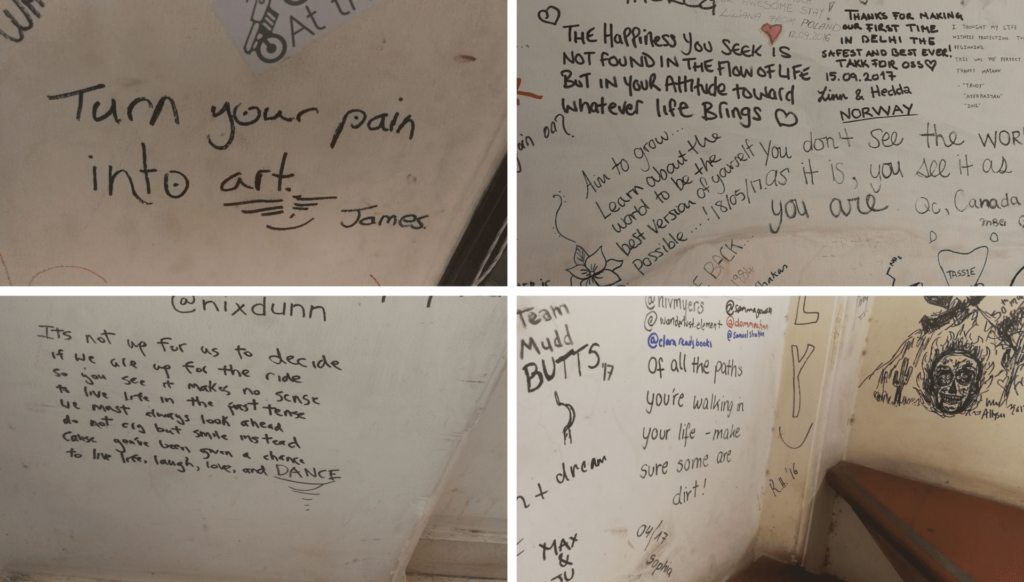
* The happiness you seek is not found in the flow of life but in your attitude toward whatever life brings
* It's not up for us to decide if we are up for the ride. So you see it makes no sense to live life in the past tense. We must always look ahead. Do not clg but smile instead. Cause you've been given a chance to live life, laugh, love, and dance
* Of all the paths you're walking in your life - make sure some are dirt!
3. People experience feeling lost and work on finding themselves:

* The real voyage of discovery consists not in seeking new landscapes, but in having new eyes
* It's not who you are that holds you back. It is who you think you are not
* Just remember ... a journey of a thousand miles must begin with a single step
4. People realize that the answers they seek are unique and that they can trust themselves:

* It is better to live your own destiny imperfectly than to live an imitation of somebody else's life with perfection
* I am the universe, I know it to be true. I create and I destroy. I am the designer of my reality
* Feel the fear and do it anyways
5. People find a deeper value in living in the present:

* Time is the only thing ... only thing in life that isn't on our side ... always live!
* When travelling: Don't try to see as many places as you can. Try to be at places as much as you can (<-yes!)
* To improve is to change, to be perfect is to change often
6. People realize with their reality-bending force, they can choose a perspective of joy:
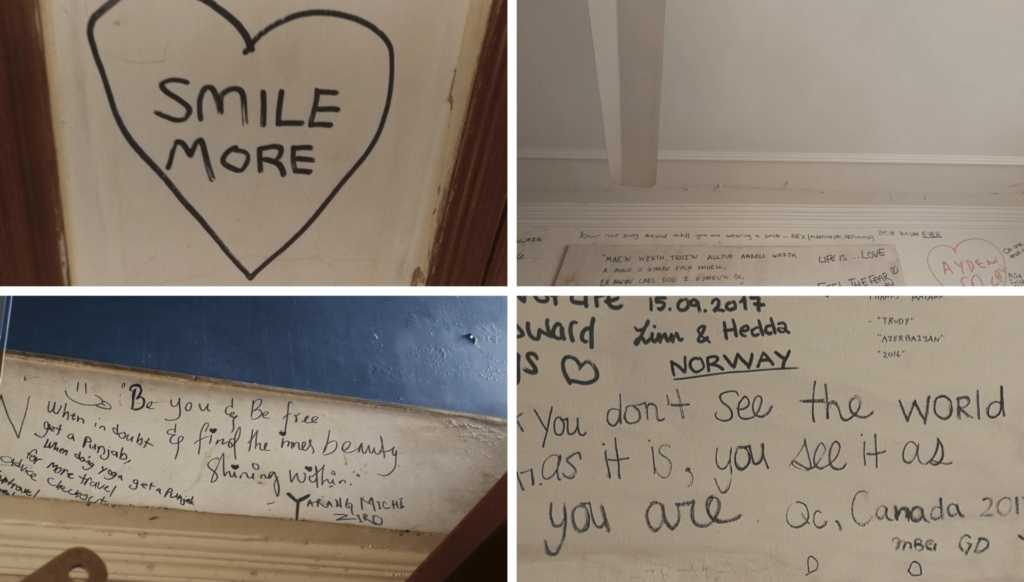
* You are not fully dressed until you are wearing a smile
* Be you & Be free & Find the beauty shining within
* You don't see the world as it is, you see it as you are
7. People just live their lives based on what feels good and avoid getting lost in philosophy:

* Be cool man, just be cool. Be true to yourself, and ... well, fuck these people! Cunts!
* Live life like a true adventurer and not a pansy nine-to-fiver who gets all cranky when he misses lunch
* Chat shit, get banged. Best nights in Delhi!
In Delhi I felt tired and happy, I felt human. And I felt a flood of emotions – for me the transition from living on the bike to flying home was intense. What had I just done?
I didn’t write a slogan on the hostel wall – I felt too overwhelmed to add something like “my bottom line” or anything like that.
I guess everyone processes traveling differently. Personally, I gave myself years to reflect on my Silk Road experiences before I had sufficient inner clarity to begin writing things down.
If today I had to pick a single insight or lesson or bottom line from my journey which resonated with me the most, which changed me personally the most, and which I believe is the most powerful idea to live healthy and authentic while making our world a better place, it’s without doubt this one – an idea also found written by others on the hostel wall:
I returned to Berlin with Aeroflot and a stopover in Moscow. I could check in two 23 kg bags which was more than enough for my bike and all equipment without paying extra.
I returned to Berlin 303 days after I left.





